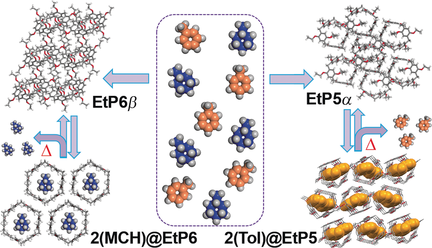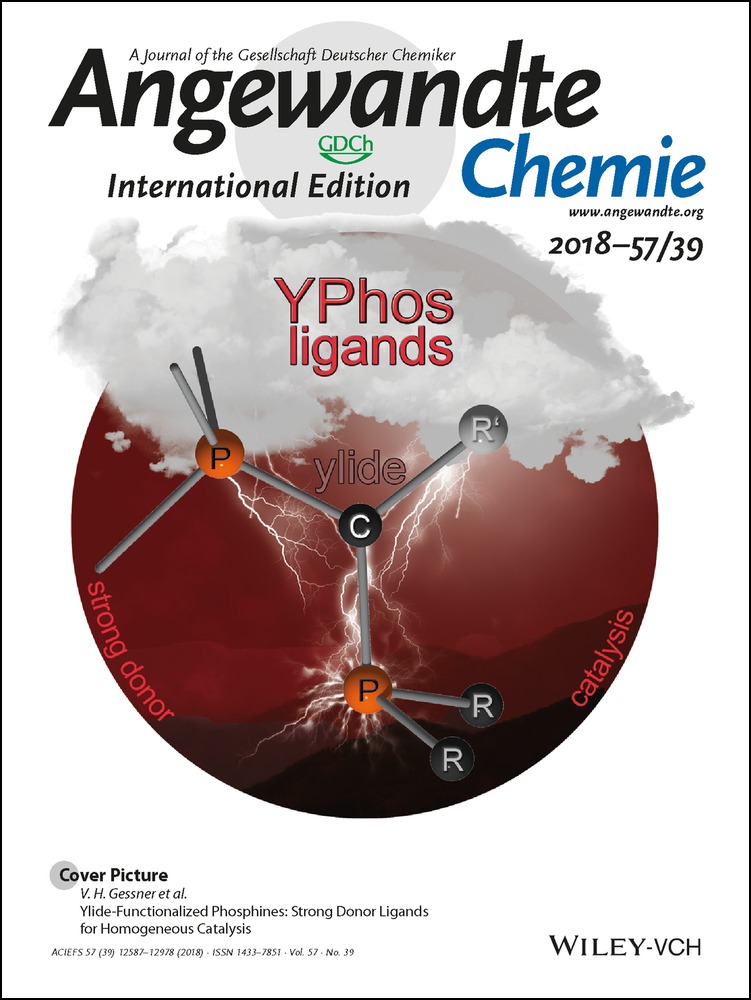Separation of Aromatics/Cyclic Aliphatics by Nonporous Adaptive Pillararene Crystals
Kecheng Jie
State Key Laboratory of Chemical Engineering, Center for Chemistry of High-Performance & Novel Materials, Department of Chemistry, Zhejiang University, Hangzhou, 310027 P. R. China
Search for more papers by this authorYujuan Zhou
State Key Laboratory of Chemical Engineering, Center for Chemistry of High-Performance & Novel Materials, Department of Chemistry, Zhejiang University, Hangzhou, 310027 P. R. China
Search for more papers by this authorErrui Li
State Key Laboratory of Chemical Engineering, Center for Chemistry of High-Performance & Novel Materials, Department of Chemistry, Zhejiang University, Hangzhou, 310027 P. R. China
Search for more papers by this authorRun Zhao
State Key Laboratory of Chemical Engineering, Center for Chemistry of High-Performance & Novel Materials, Department of Chemistry, Zhejiang University, Hangzhou, 310027 P. R. China
Search for more papers by this authorCorresponding Author
Prof. Dr. Feihe Huang
State Key Laboratory of Chemical Engineering, Center for Chemistry of High-Performance & Novel Materials, Department of Chemistry, Zhejiang University, Hangzhou, 310027 P. R. China
Search for more papers by this authorKecheng Jie
State Key Laboratory of Chemical Engineering, Center for Chemistry of High-Performance & Novel Materials, Department of Chemistry, Zhejiang University, Hangzhou, 310027 P. R. China
Search for more papers by this authorYujuan Zhou
State Key Laboratory of Chemical Engineering, Center for Chemistry of High-Performance & Novel Materials, Department of Chemistry, Zhejiang University, Hangzhou, 310027 P. R. China
Search for more papers by this authorErrui Li
State Key Laboratory of Chemical Engineering, Center for Chemistry of High-Performance & Novel Materials, Department of Chemistry, Zhejiang University, Hangzhou, 310027 P. R. China
Search for more papers by this authorRun Zhao
State Key Laboratory of Chemical Engineering, Center for Chemistry of High-Performance & Novel Materials, Department of Chemistry, Zhejiang University, Hangzhou, 310027 P. R. China
Search for more papers by this authorCorresponding Author
Prof. Dr. Feihe Huang
State Key Laboratory of Chemical Engineering, Center for Chemistry of High-Performance & Novel Materials, Department of Chemistry, Zhejiang University, Hangzhou, 310027 P. R. China
Search for more papers by this authorGraphical Abstract
Energy-efficient separation of aromatics and cyclic aliphatics is a major industrial sustainability challenge. A flexible molecular material, namely nonporous adaptive crystals of pillararenes, can be used to separate them. Pillar[5]arene is shown to separate vapors of toluene from methylcyclohexane, while pillar[6]arene separates methylcyclohexane from toluene with over 98 % specificity in the solid state.
Abstract
The separation of cyclic aliphatics of high purity, which are produced from hydrogenation of the corresponding aromatics, is highly desired in the chemical industry. An energy-efficient and environmentally friendly adsorptive separation method using nonporous adaptive crystals of perethylated pillar[5]arene (EtP5) and pillar[6]arene (EtP6) is described. Adaptive EtP5 crystals separate toluene from methylcyclohexane with 98.8 % purity, while adaptive EtP6 crystals separate methylcyclohexane from toluene with 99.2 % purity. The selectivities come from the stability of new EtP5 and EtP6 crystal structures upon capture of toluene and methylcyclohexane, respectively. The reversible transformations between nonporous guest-free EtP5 or EtP6 structures and guest-loaded structures make them highly recyclable.
Supporting Information
As a service to our authors and readers, this journal provides supporting information supplied by the authors. Such materials are peer reviewed and may be re-organized for online delivery, but are not copy-edited or typeset. Technical support issues arising from supporting information (other than missing files) should be addressed to the authors.
| Filename | Description |
|---|---|
| anie201808998-sup-0001-crystals.cif2 MB | Supplementary |
| anie201808998-sup-0001-misc_information.pdf2.1 MB | Supplementary |
Please note: The publisher is not responsible for the content or functionality of any supporting information supplied by the authors. Any queries (other than missing content) should be directed to the corresponding author for the article.
References
- 1R. A. Meyers, Handbook of Petroleum Refining Process, McGraw-Hill, New York, 1997.
- 2
- 2a“Hydrocarbons”: K. Griesbaum, A. Behr, B. D. iedenkapp, H.-W. Voges, D. Garbe, C. Paetz, G. Collin, D. Mayer, H. Höke, Ullman's Encyclopedia of Industrial Chemistry, Electronic Release, Wiley-VCH, Weinheim, 2012;
- 2bY. Wan, C. Chen, W. M. Xiao, L. J. Jian, N. Zhang, Microporous Mesoporous Mater. 2013, 171, 9;
- 2cS. Y. Nam, J. R. Dorgan, J. Membr. Sci. 2007, 306, 186;
- 2dL. D. Shiau, C. C. Yu, Sep. Purif. Technol. 2009, 66, 422.
- 3
- 3aA. Takahashi, F. H. Yang, R. T. Yang, Ind. Eng. Chem. Res. 2000, 39, 3856;
- 3bM.-H. Zeng, Y.-X. Tan, Y.-P. He, Z. Yin, Q. Chen, M. Kurmoo, Inorg. Chem. 2013, 52, 2353;
- 3cS. B. Kuila, S. K. Ray, Sep. Purif. Technol. 2014, 123, 45.
- 4J. P. Garcia-Villaluenga, A. Tabe-Mohammadi, J. Membr. Sci. 2000, 169, 159.
- 5
- 5aL. Berg, U.S. Patent 5 458 741, 1995;
- 5bW. Yin, S. Ding, S. Xia, P. Ma, X. Huang, Z. Zhu, J. Chem. Eng. Data 2010, 55, 3274.
- 6
- 6aZ. Bao, G. Chang, H. Xing, R. Krishna, Q. Ren, B. Chen, Energy Environ. Sci. 2016, 9, 3612;
- 6bZ. R. Herm, E. D. Bloch, J. R. Long, Chem. Mater. 2014, 26, 323;
- 6cD. Kim, M. Y. Jeon, B. L. Stottrup, M. Tsapatsis, Angew. Chem. Int. Ed. 2018, 57, 480; Angew. Chem. 2018, 130, 489;
- 6dT. Hasell, A. I. Cooper, Nat. Rev. Mater. 2016, 1, 16053.
- 7
- 7aC.-Y. Huang, M. Song, Z.-Y. Gu, H.-F. Wang, X.-P. Yan, Environ. Sci. Technol. 2011, 45, 4490;
- 7bY. Hijikata, S. Horike, M. Sugimoto, H. Sato, R. Matsuda, S. Kitagawa, Chem. Eur. J. 2011, 17, 5138;
- 7cM. Eddaoudi, H. L. Li, O. M. Yaghi, J. Am. Chem. Soc. 2000, 122, 1391;
- 7dE. L. First, C. E. Gounaris, C. A. Floudas, Langmuir 2013, 29, 5599;
- 7eC.-T. He, J.-Y. Tian, S.-Y. Liu, G. Ouyang, J.-P. Zhang, X.-M. Chen, Chem. Sci. 2013, 4, 351.
- 8
- 8aT. Ogoshi, S. Kanai, S. Fujinami, T. Yamagishi, Y. Nakamoto, J. Am. Chem. Soc. 2008, 130, 5022;
- 8bM. Xue, Y. Yang, X. Chi, Z. Zhang, F. Huang, Acc. Chem. Res. 2012, 45, 1294;
- 8cT. Ogoshi, T.-a. Yamagishi, Y. Nakamoto, Chem. Rev. 2016, 116, 7937.
- 9
- 9aW. Si, L. Chen, X.-B. Hu, G. Tang, Z. Chen, J.-L. Hou, Z.-T. Li, Angew. Chem. Int. Ed. 2011, 50, 12564; Angew. Chem. 2011, 123, 12772;
- 9bS.-H. Li, H.-Y. Zhang, X. Xu, Y. Liu, Nat. Commun. 2015, 6, 7590;
- 9cT. Ogoshi, R. Sueto, K. Yoshikoshi, Y. Sakata, S. Akine, T.-a. Yamagishi, Angew. Chem. Int. Ed. 2015, 54, 9849; Angew. Chem. 2015, 127, 9987;
- 9dS. N. Talapaneni, D. Kim, G. Barin, O. Buyukcakir, S. H. Je, A. Coskun, Chem. Mater. 2016, 28, 4460;
- 9eH. Li, D.-X. Chen, Y.-L. Sun, Y. Zheng, L.-L. Tan, P. S. Weiss, Y.-W. Yang, J. Am. Chem. Soc. 2013, 135, 1570;
- 9fX. Chi, G. Yu, L. Shao, J. Chen, F. Huang, J. Am. Chem. Soc. 2016, 138, 3168;
- 9gT. Ogoshi, K. Saito, R. Sueto, R. Kojima, Y. Hamada, S. Akine, A. M. P. Moeljadi, H. Hirao, T. Kakuta, T.-a. Yamagishi, Angew. Chem. Int. Ed. 2018, 57, 1592; Angew. Chem. 2018, 130, 1608;
- 9hH. Zhang, Z. Liu, Y. Zhao, Chem. Soc. Rev. 2018, 47, 5491.
- 10
- 10aK. Jie, M. Liu, Y. Zhou, M. Little, S. Bonakala, S. Chong, A. Stephenson, L. Chen, F. Huang, A. I. Cooper, J. Am. Chem. Soc. 2017, 139, 2908;
- 10bK. Jie, Y. Zhou, E. Li, Z. Li, R. Zhao, F. Huang, J. Am. Chem. Soc. 2017, 139, 15320;
- 10cK. Jie, Y. Zhou, E. Li, R. Zhao, M. Liu, F. Huang, J. Am. Chem. Soc. 2018, 140, 3190;
- 10dK. Jie, M. Liu, Y. Zhou, M. A. Little, A. Pulido, S. Y. Chong, A. Stephenson, A. R. Hughes, F. Sakakibara, T. Ogoshi, F. Blanc, G. M. Day, F. Huang, A. I. Cooper, J. Am. Chem. Soc. 2018, 140, 6921.
- 11
- 11aS. Horike, S. Shimomura, S. Kitagawa, Nat. Chem. 2009, 1, 695;
- 11bT. K. Maji, R. Matsuda, S. Kitagawa, Nat. Mater. 2007, 6, 142;
- 11cH. J. Choi, M. P. Suh, J. Am. Chem. Soc. 2004, 126, 15844.





